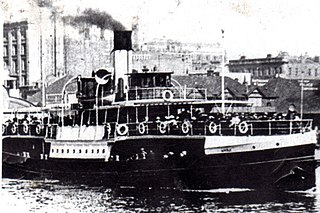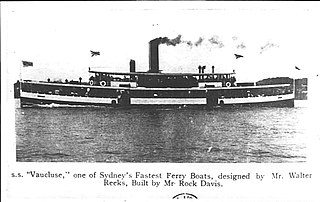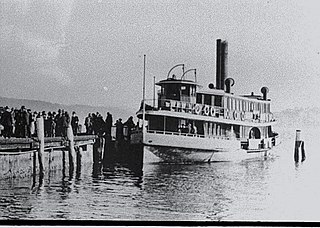Related Research Articles

A paddle steamer is a steamship or steamboat powered by a steam engine that drives paddle wheels to propel the craft through the water. In antiquity, paddle wheelers followed the development of poles, oars and sails, where the first uses were wheelers driven by animals or humans.

Sydney Ferries is the public transport ferry network serving the city of Sydney, New South Wales. Services operate on Sydney Harbour and the connecting Parramatta River. The network is controlled by the New South Wales Government's transport authority, Transport for NSW, and is part of the authority's Opal ticketing system. In 2017–18, 15.3 million passenger journeys were made on the network.
Surprise was the first paddle steamer, and the first steam powered vessel, built and run in Australia. It was built possibly on the Parramatta River, by shipbuilder Henry Gilbert, and launched in Sydney on 14 March 1831. The vessel was 24 metres long with a draught of 0.6 metres.

Sophia Jane was the first paddle steamer to operate in the coastal waters of New South Wales (NSW). She was launched on the Thames in 1826 and arrived in Sydney in May 1831.

Manly ferry services operate on Sydney Harbour connecting the Sydney suburb of Manly with Circular Quay in the CBD a journey of seven nautical miles.

The Herald was an iron paddle steamer imported as frames from the United Kingdom and assembled in 1855 by Richard Johnson in Sydney Harbour, New South Wales, Australia, where she was registered. The Herald is one of the earliest iron paddle wheel steamers built in Australia, where she operated within Sydney Harbour. She was initially used on the fledgling North Shore route between Dawes Point and Blues Point by the newly formed North Shore Steam Company; however, due to not enough traffic to make her financially viable, she often performed tug duties. Eventually the North Shore Steam Company was wound up; the vessel was put up for sale but continued picking up business wherever it was available, operating as a tug, ferry, excursion boat and cargo vessel.
Sydney Ferries Limited operated ferry services on Sydney Harbour from 1900 until June 1951.

Bellubera was a ferry operated by the Port Jackson & Manly Steamship Company on the Manly service. Launched in 1910, she was the third of six "Binngarra-type" vessels. Upon her 1936 conversion from steam power, she became the first diesel-electric vessel in Australia. She was decommissioned in 1973, and scuttled at sea in 1980.

The Karingal and Karrabee were near identical sister ferries operated by Sydney Ferries Limited and its NSW State Government operated successors on Sydney Harbour from 1913 until 1984. Wooden ferries built at the time of Sydney Ferries' rapid early twentieth century, they were the smallest of the round-end "K-class ferries".

Binngarra was a ferry operated by the Port Jackson Co-operative Steamship Company, which became the Port Jackson & Manly Steamship Company, on the Manly service. Launched in 1905, she was the first of six similar vessels built for the company–the Binngarra class—the success of which saw three of her sister vessels serving through to the 1970s and 1980s.

Manly (II) was a ferry that served on the Sydney to Manly run from 1896 to 1924.

Wallaby was a ferry that operated on Sydney Harbour.

Vaucluse was a ferry on Sydney Harbour that served on the Circular Quay to Watsons Bay run. She was launched in 1905, and was one of the fastest ferries in Sydney. She was sent to Newcastle after which her fate is unknown.

Emu (II), later Brightside, was an iron paddle steamer that operated on the Brisbane River, Moreton Bay, and on Sydney Harbour. The vessel was originally built in 1865 as Emu by A & J Inglis of Glasgow. She was imported in sections and assembled at Kangaroo Point, Brisbane. She had two inverted diagonal steam engines, providing 70 hp and capable of pushing her to 10 knots.

Fairlight was a paddle steamer ferry that operated on the Circular Quay to Manly run from 1878 to 1914. She was the third double-ended steamer on the Manly run and first to be specifically designed for the route.

Kameruka and Kamiri were near identical ferries that served on Sydney Harbour. Kamiri was built in 1912 and Kameruka was launched on 8 February 1913. They were double-ended "K-class" steam ferries, a type that was prolific on Sydney Harbour in the early 20th century boom in cross-Sydney Harbour ferry transport before the 1932 opening of the Sydney Harbour Bridge. Kamiri was laid up in 1951 following the New South Wales government take-over of the Sydney Ferries Limited. Kameruka was converted to diesel in 1954 and was laid up in 1984.

Lady Edeline was a Sydney Harbour ferry built in 1913 for the Balmain New Ferry Company. She and four similar ferries, Lady Chelmsford (1910), Lady Denman (1912), Lady Ferguson (1914), Lady Scott (1914) were a new series of "Lady-class", designed by renowned naval architect, Walter Reeks.

Lady Ferguson was a Sydney Harbour ferry built in 1914 for the Balmain New Ferry Company. She and four similar ferries, Lady Chelmsford (1910), Lady Denman (1912), Lady Edeline (1913), and Lady Scott (1914), were a new series of "Lady-class", designed by renowned naval architect, Walter Reeks.

Sydney Harbour ferry services date back to the first years of Sydney's European settlement. Slow and sporadic boats ran along the Parramatta River from Sydney to Parramatta and served the agricultural settlements in between. By the mid-1830s, speculative ventures established regular services. From the late-nineteenth century the North Shore developed rapidly. A rail connection to Milsons Point took alighting ferry passengers up the North Shore line to Hornsby, New South Wales via North Sydney. Without a bridge connection, increasingly large fleets of steamers serviced the cross habour routes and in the early twentieth century, Sydney Ferries Limited was the largest ferry operator in the world.

Kookooburra was a "K-class" ferry on Sydney Harbour. Commissioned in 1907, the timber-hulled steamer was built for Sydney Ferries Limited during the boom in cross-harbour ferry travel prior to the opening of the Sydney Harbour Bridge. She was retired from Sydney Harbour service in 1947 after which she was sent to Newcastle. She is thought to have been broken up in 1959.
References
- Andrews, Graeme (1982). A Pictorial History of Ferries: Sydney and Surrounding Waterways. Sydney: AH & AW Reed Pty Ltd. pp. 10&11. ISBN 0589503863.
- Gunter, John (1978). Across the harbour : the story of Sydney's ferries. Rigby. p. 11. ISBN 0727007157.
| This ferry article is a stub. You can help Wikipedia by expanding it. |